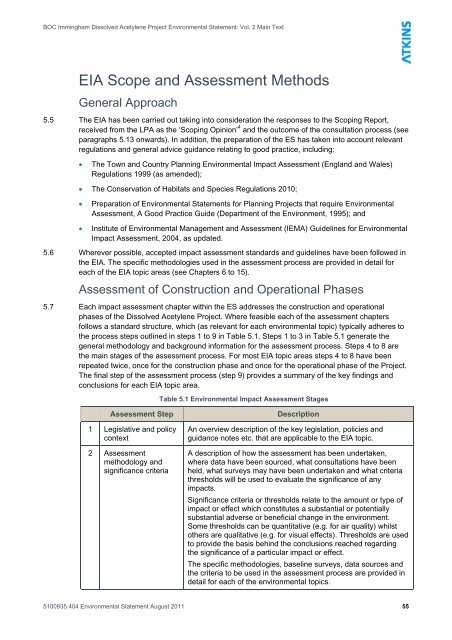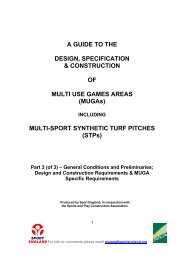View - North East Lincolnshire Council
View - North East Lincolnshire Council
View - North East Lincolnshire Council
Create successful ePaper yourself
Turn your PDF publications into a flip-book with our unique Google optimized e-Paper software.
BOC Immingham Dissolved Acetylene Project Environmental Statement: Vol. 2 Main Text<br />
EIA Scope and Assessment Methods<br />
General Approach<br />
5.5 The EIA has been carried out taking into consideration the responses to the Scoping Report,<br />
received from the LPA as the ‘Scoping Opinion’ 4 and the outcome of the consultation process (see<br />
paragraphs 5.13 onwards). In addition, the preparation of the ES has taken into account relevant<br />
regulations and general advice guidance relating to good practice, including:<br />
� The Town and Country Planning Environmental Impact Assessment (England and Wales)<br />
Regulations 1999 (as amended);<br />
� The Conservation of Habitats and Species Regulations 2010;<br />
� Preparation of Environmental Statements for Planning Projects that require Environmental<br />
Assessment, A Good Practice Guide (Department of the Environment, 1995); and<br />
� Institute of Environmental Management and Assessment (IEMA) Guidelines for Environmental<br />
Impact Assessment, 2004, as updated.<br />
5.6 Wherever possible, accepted impact assessment standards and guidelines have been followed in<br />
the EIA. The specific methodologies used in the assessment process are provided in detail for<br />
each of the EIA topic areas (see Chapters 6 to 15).<br />
Assessment of Construction and Operational Phases<br />
5.7 Each impact assessment chapter within the ES addresses the construction and operational<br />
phases of the Dissolved Acetylene Project. Where feasible each of the assessment chapters<br />
follows a standard structure, which (as relevant for each environmental topic) typically adheres to<br />
the process steps outlined in steps 1 to 9 in Table 5.1. Steps 1 to 3 in Table 5.1 generate the<br />
general methodology and background information for the assessment process. Steps 4 to 8 are<br />
the main stages of the assessment process. For most EIA topic areas steps 4 to 8 have been<br />
repeated twice, once for the construction phase and once for the operational phase of the Project.<br />
The final step of the assessment process (step 9) provides a summary of the key findings and<br />
conclusions for each EIA topic area.<br />
Table 5.1 Environmental Impact Assessment Stages<br />
Assessment Step Description<br />
1 Legislative and policy<br />
context<br />
2 Assessment<br />
methodology and<br />
significance criteria<br />
An overview description of the key legislation, policies and<br />
guidance notes etc. that are applicable to the EIA topic.<br />
A description of how the assessment has been undertaken,<br />
where data have been sourced, what consultations have been<br />
held, what surveys may have been undertaken and what criteria<br />
thresholds will be used to evaluate the significance of any<br />
impacts.<br />
Significance criteria or thresholds relate to the amount or type of<br />
impact or effect which constitutes a substantial or potentially<br />
substantial adverse or beneficial change in the environment.<br />
Some thresholds can be quantitative (e.g. for air quality) whilst<br />
others are qualitative (e.g. for visual effects). Thresholds are used<br />
to provide the basis behind the conclusions reached regarding<br />
the significance of a particular impact or effect.<br />
The specific methodologies, baseline surveys, data sources and<br />
the criteria to be used in the assessment process are provided in<br />
detail for each of the environmental topics.<br />
5100935.404 Environmental Statement August 2011 55




